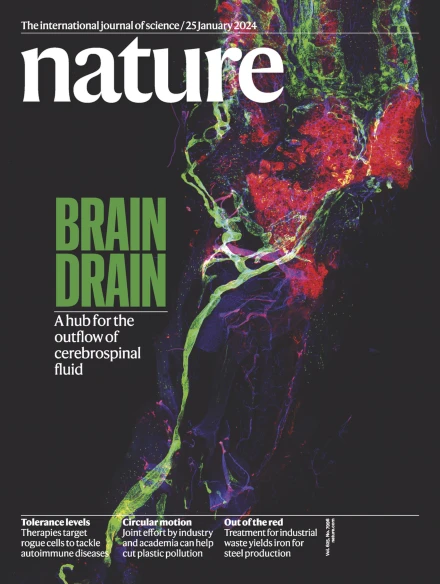检测无细胞 RNA 的超灵敏方法
IF 50.5
1区 综合性期刊
Q1 MULTIDISCIPLINARY SCIENCES
引用次数: 0
摘要
检测无细胞RNA (cfRNA)的灵敏方法可以促进非侵入性基因表达谱和疾病监测1,2,3,4,5,6。在这里,我们描述了RARE-seq(随机引物和亲和力捕获cfRNA片段,通过测序进行富集分析),这是一种优化的cfRNA分析方法。我们证明了血小板污染可以极大地混淆cfRNA分析,并开发了一种克服它的方法。在分析验证中,我们发现RARE-seq检测肿瘤源性cfRNA的灵敏度比全转录组RNA测序(RNA-seq)高约50倍,检测限为0.05%。为了探索临床应用,我们分析了来自369名癌症或非恶性疾病患者和对照组的437份血浆样本。在cfRNA中检测到的非小细胞肺癌表达特征随着分期的增加而增加(20人中有6人(30%)在I期;II期5 / 8 (63%);15例中有10例(67%)处于III期;96例IV期患者中有80例(83%敏感性,95%特异性)和RARE-seq比肿瘤初始循环肿瘤DNA (ctDNA)分析更敏感。在对酪氨酸激酶抑制剂产生耐药的egfr突变的非小细胞肺癌患者中,我们检测了组织学转化和基于突变的耐药机制。最后,我们证明了RARE-seq在确定组织来源、评估良性肺部疾病和跟踪mRNA疫苗反应方面的潜在效用。这些结果突出了超灵敏cfRNA分析的潜在价值,并为各种临床应用提供了概念证明。本文章由计算机程序翻译,如有差异,请以英文原文为准。

An ultrasensitive method for detection of cell-free RNA
Sensitive methods for detection of cell-free RNA (cfRNA) could facilitate non-invasive gene expression profiling and monitoring of diseases1–6. Here we describe RARE-seq (random priming and affinity capture of cfRNA fragments for enrichment analysis by sequencing), a method optimized for cfRNA analysis. We demonstrate that platelet contamination can substantially confound cfRNA analyses and develop an approach to overcome it. In analytical validations, we find RARE-seq to be approximately 50-fold more sensitive for detecting tumour-derived cfRNA than whole-transcriptome RNA sequencing (RNA-seq), with a limit of detection of 0.05%. To explore clinical utility, we profiled 437 plasma samples from 369 individuals with cancer or non-malignant conditions and controls. Detection of non-small-cell lung cancer expression signatures in cfRNA increased with stage (6 out of 20 (30%) in stage I; 5 out of 8 (63%) in stage II; 10 out of 15 (67%) in stage III; 80 out of 96 (83% sensitivity) in stage IV at 95% specificity) and RARE-seq was more sensitive than tumour-naive circulating tumour DNA (ctDNA) analysis. In patients with EGFR-mutant non-small-cell lung cancer who developed resistance to tyrosine kinase inhibitors, we detected both histological transformation and mutation-based resistance mechanisms. Finally, we demonstrate the potential utility of RARE-seq for determination of tissue of origin, assessing benign pulmonary conditions and tracking response to mRNA vaccines. These results highlight the potential value of ultrasensitive cfRNA analysis and provide proof of concept for diverse clinical applications. A method, RARE-seq, for sensitive detection of cell-free RNAs in blood is demonstrated to have diverse clinical applications including diagnosing and characterizing human cancers, and tracking response to RNA therapeutics.
求助全文
通过发布文献求助,成功后即可免费获取论文全文。
去求助
来源期刊

Nature
综合性期刊-综合性期刊
CiteScore
90.00
自引率
1.20%
发文量
3652
审稿时长
3 months
期刊介绍:
Nature is a prestigious international journal that publishes peer-reviewed research in various scientific and technological fields. The selection of articles is based on criteria such as originality, importance, interdisciplinary relevance, timeliness, accessibility, elegance, and surprising conclusions. In addition to showcasing significant scientific advances, Nature delivers rapid, authoritative, insightful news, and interpretation of current and upcoming trends impacting science, scientists, and the broader public. The journal serves a dual purpose: firstly, to promptly share noteworthy scientific advances and foster discussions among scientists, and secondly, to ensure the swift dissemination of scientific results globally, emphasizing their significance for knowledge, culture, and daily life.
 求助内容:
求助内容: 应助结果提醒方式:
应助结果提醒方式:


